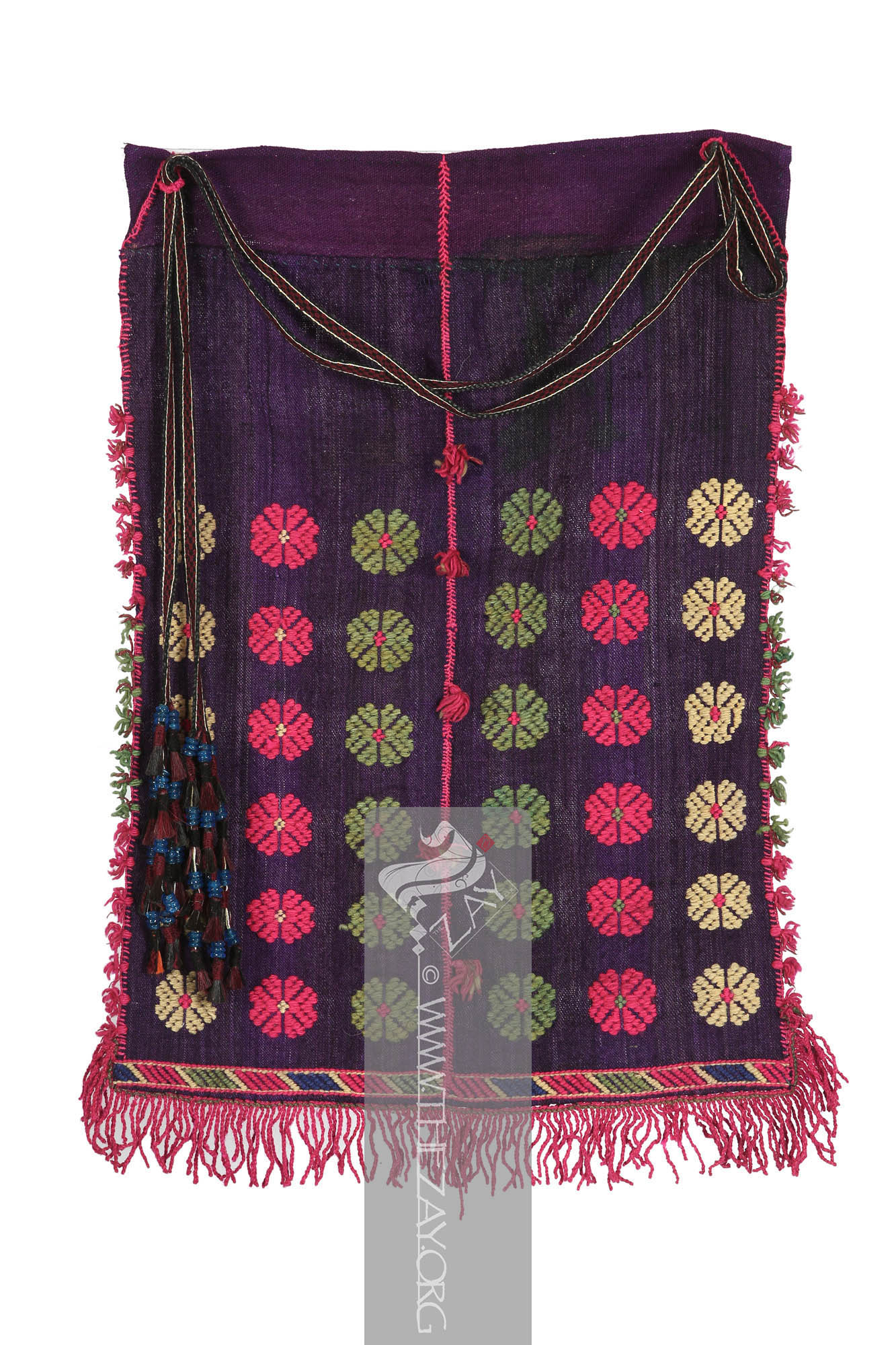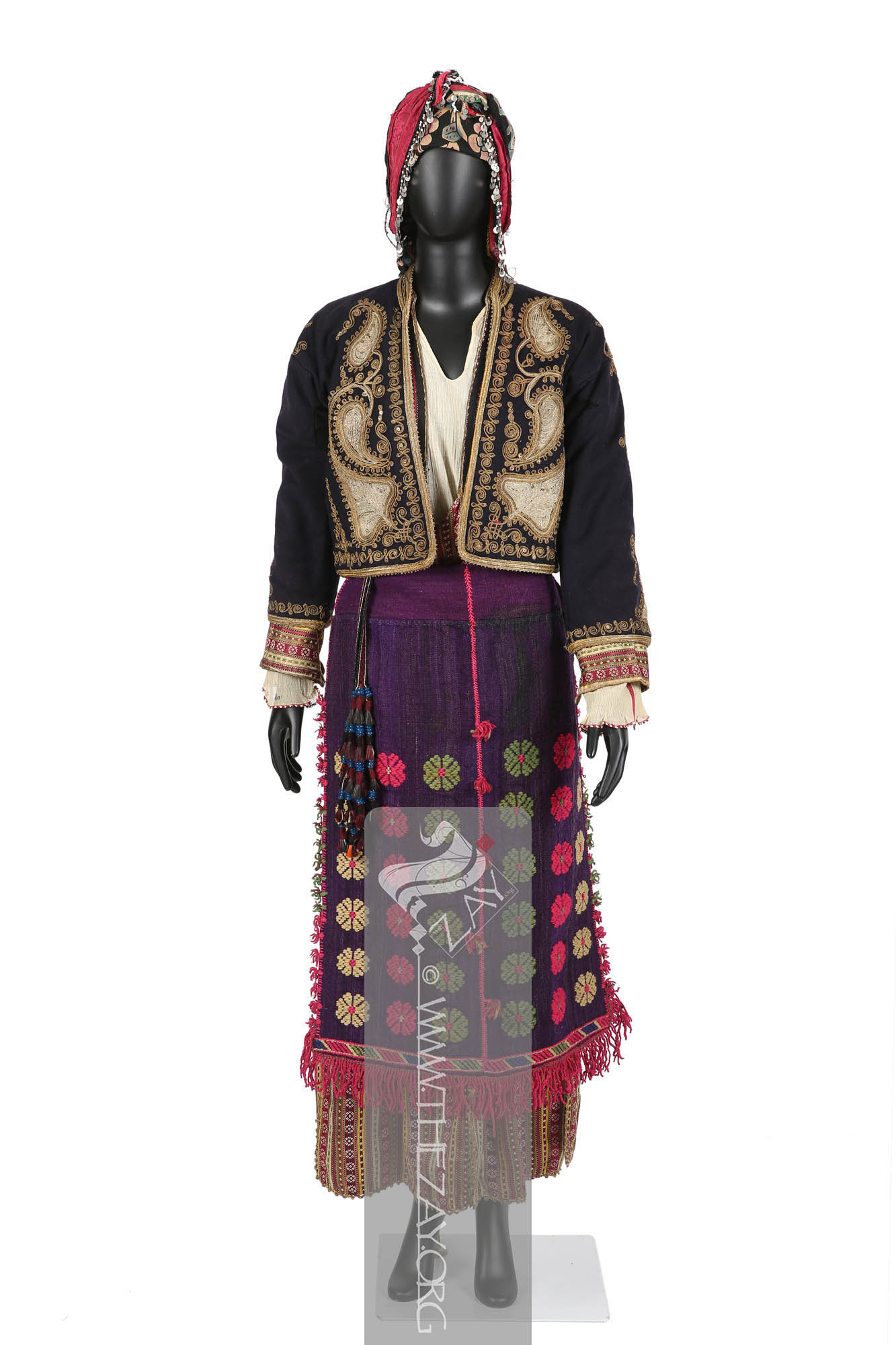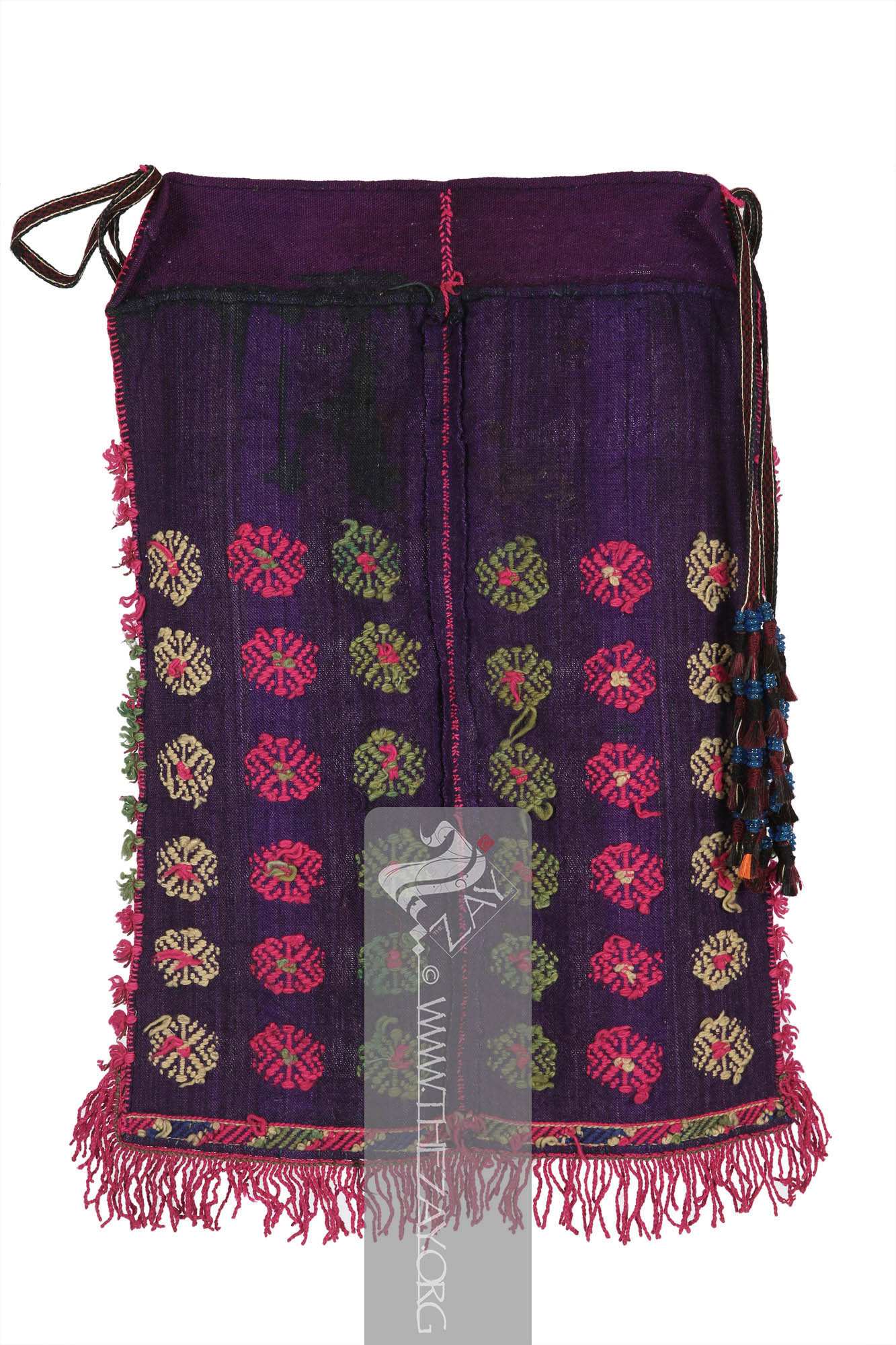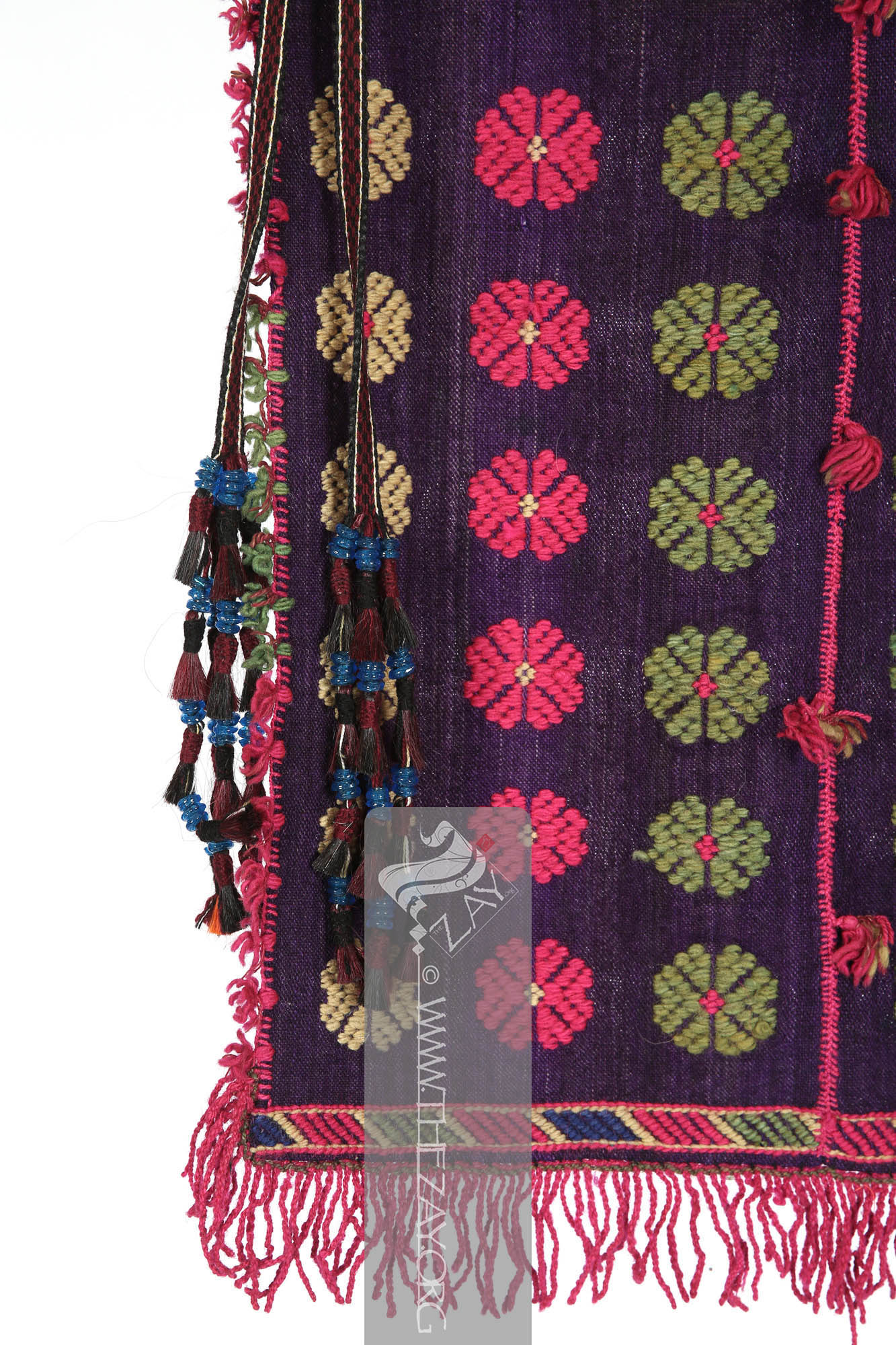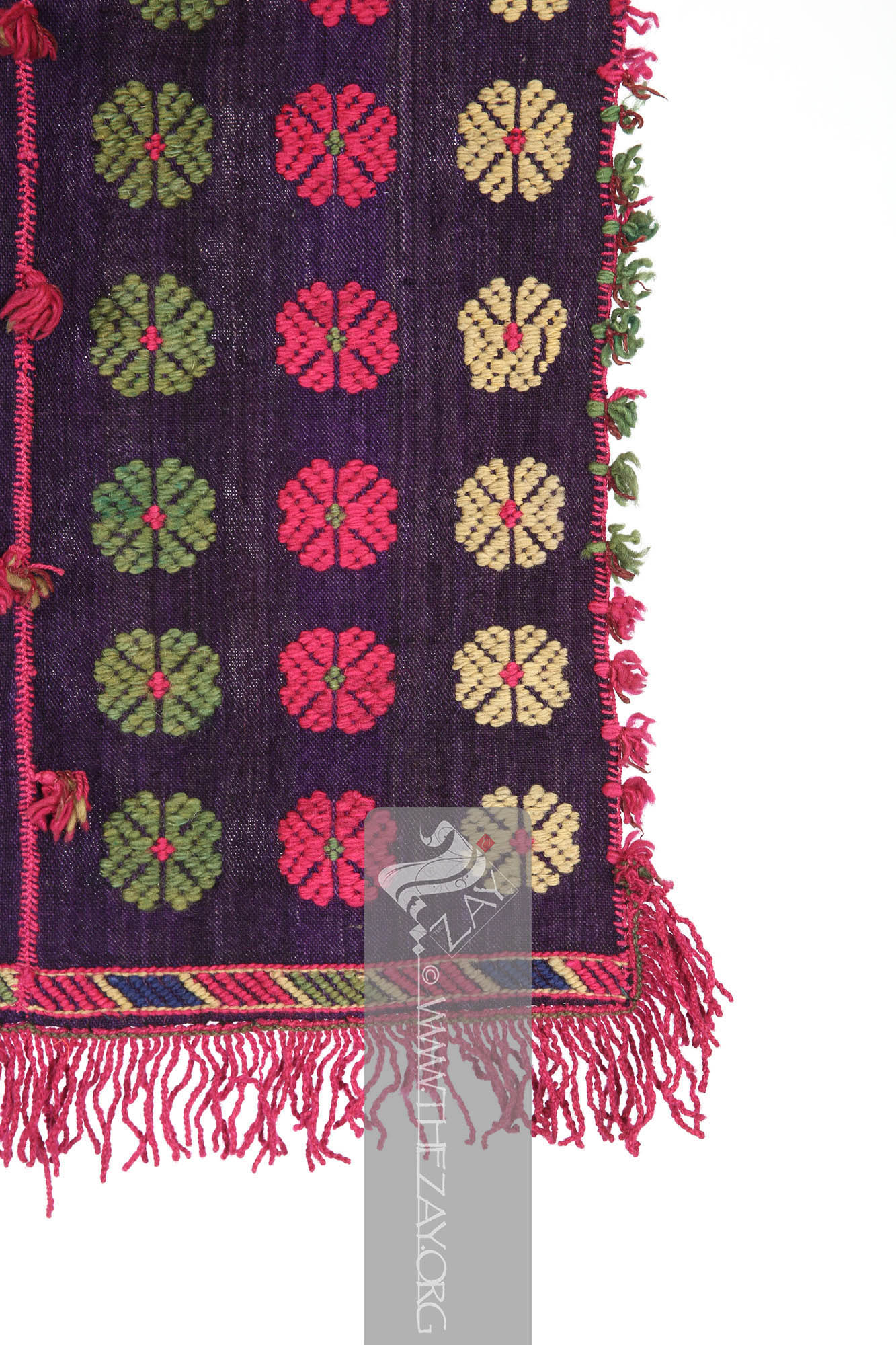Object NotePart of an ensemble with four more pieces (
ZI2018.500642 ASIA,
ZI2018.500642a ASIA,
ZI2018.500642b ASIA, and
ZI2018.500642c ASIA).
Object History This piece of garment was purchased by
Dr. Reem Tariq
Ṭariq: (Arabic; Synonym: tulle_bi_talli
Tūlle_bi_tallī: (French: Tulle – a city in France where fine material for veil was first made; Turkish: tel – wire; Synonym: tariq; talli; badla; khus_dozi ), series of small metal knots made on a woven net ground as embellishment. The term is commonly used in the North African Arab region specifically in Egypt.
; talli; badla; khus_dozi ), series of small metal knots made on a woven net ground as embellishment. The term is commonly used in the Levant Arab region specifically in Lebanon.
El Mutwalli
Dr. Reem Tariq
Ṭariq: (Arabic; Synonym: tulle_bi_talli
Tūlle_bi_tallī: (French: Tulle – a city in France where fine material for veil was first made; Turkish: tel – wire; Synonym: tariq; talli; badla; khus_dozi ), series of small metal knots made on a woven net ground as embellishment. The term is commonly used in the North African Arab region specifically in Egypt.
; talli; badla; khus_dozi ), series of small metal knots made on a woven net ground as embellishment. The term is commonly used in the Levant Arab region specifically in Lebanon.
el Mutwallī: Founder (CEO) of the Zay
Zay: (Arabic: costume, Pl. azyaā’), a set of clothes in a style typical of a particular country or historical period. Initiative, a public figure, speaker and author. An expert curator and consultant in Islamic art and architecture, interior design, historic costume, and UAE heritage. as a set of ensembles from Jade Bréval, an independent collector from France in 2018 to add to and enhance The
Zay
Zay: (Arabic: costume, Pl. azyaā’), a set of clothes in a style typical of a particular country or historical period. Initiative collection.
Ms Jade Bréval who had travelled for over 15 years in and around Türkiye had collected items such as this from shops and individuals in small villages and towns that she visited.
Object Features This is a woven woollen apron (önlük) for women in purple base and colourful embroidered floral embellishment.
The field of the apron is a woven woollen fabric in purple. The hems of the apron are embellished with (
blanket_stitch
Blanket_stitch: A basic sewing stitch used to secure the edges of fabric or create decorative borders by looping the thread over the edges of blankets, quilts, and other fabrics and pulling it through, forming a series of evenly spaced stitches that resemble a chain. ) style embroidered trimming to prevent fraying from the edges with bright pink woollen threads. It has two loops on the top corners for the fastening ribbons. It also has an added layer of woollen pompoms in pink and green attached as trimming.
The field of the apron is embellished with beige, pink and green wool creating repeats of floral motifs in simple (
satin_stitch
Satin_stitch: (Synonym: Damask Stitch), is a type of flat embroidery stitch that creates a satin like smooth and shiny surface by closely spaced stitches, covering an entire area or shape.) style embroidery. A thick woven woollen ribbon in yellow, black and red with hanging tassels constructed of horsehair pompoms and blue plastic beads is looped around the eyelets in the corner.
The önlük is constructed of two panels of fabric mirroring each other in design that has been stitched vertically and the seam is embellished with (
thorn_stitch
Thorn_stitch: (English), is an embroidery technique that involves creating raised, textured lines or motifs using a series of closely spaced, slanted stitches. By overlapping and layering the stitches, a thorny appearance is achieved, adding dimension and interest to the embroidered patterns. ) style and a layer of woollen pompoms attached down the middle.
A border near the fall hem displays a horizontal panel with diagonal rows of lines in blue, beige, pink and green woollen threads. The hemline of the fall has a series of fringes made of braided pink woollen threads sewn to it.
Just like the rest of the pieces in the ensemble, this önlük is similar to contemporary Balkan examples, especially the Romanian apron (
fota
Fota: (Ottoman Turkish: fota – Apron; from Classical Persian: futa – bath wrapper), an apron or a peasant’s skirt traditionally worn by Romanian women. It is a colourful and intricately embroidered apron, typically made of wool, linen or cotton. A symbol of cultural heritage it is worn on special occasions. ). Aprons such as these perhaps became common throughout the Ottoman Empire and particularly widespread in the north-western provinces, such as the Marmara region in present-day Türkiye, in the late 19th and early 20th centuries because of its sizeable Balkan population.
Interestingly, this kind of embroidered önlük also closely resembles the traditional Iraqi shoulder mantels (
charuga
Charuga: (Possibly Kurdish), a mantle-like embroidered women’s traditional garment from the Qaraqosh region in northern Iraq, traditionally fastened at the shoulder. Historically worn by field workers, it helped conceal dust and dirt, making them less visible during labour, it is a festive garment worn sparingly during festivals and other special occasions.
) (ZI2022.500999.7 IRAQ and ZI2022.500999.15 IRAQ) in its embellishment and design elements. Additionally, while the word
fota
Fota: (Ottoman Turkish: fota – Apron; from Classical Persian: futa – bath wrapper), an apron or a peasant’s skirt traditionally worn by Romanian women. It is a colourful and intricately embroidered apron, typically made of wool, linen or cotton. A symbol of cultural heritage it is worn on special occasions. which is derived from a classical Persian word for bath towel (
futa
Futa: (Classical Persian), a cloth used either as an apron or a bath wrapper ) means an apron, a similar sounding word in Arabic (
futah
Fūṭah: (Arabic, Classical Persian: futa – bath wrapper), a piece of cloth that either covers the head and/or the torso of a person. ) also derived from the same classical Persian word denotes any cloth that covers the head and the upper body.
At its peak, the Ottoman Empire spanned three continents and served as the crossroads between the East and the West – the Fertile Crescent, the Levant, Eastern Europe including the Balkans till the southern edge of the Great Hungarian Plain, Northern Africa and Eastern Mediterranean.
After the conquest of the Arab world in c. 1516-1517 CE its control over the Middle East lasted for four centuries until the early 20th century with the onset of WW I and the Arab Revolt. These four hundred years witnessed many instances of mutual Arab and Ottoman cultural influences and exchanges. Through areas such as social life and art – decorative and performing –we come across several instances of Arab and Turkish culture blending together through the centuries.
Just as European fashion was often inspired by the French court this socio-cultural blending between Ottoman Turkey and the Middle East was clearly reflected in its fashion and material culture.
Thus, while emulating Ottoman fashion as the mark of class in the Arab world was one side of the puzzle adapting Eastern European fashion particularly Balkan as part of mainstream couture culture because of the sizable Balkan population within the Empire was another. Therefore, it is not surprising to find several articles of clothing and their terms similar between the two cultures.
Links
- Cangökçe, Hadiye, et al. Osmanlı İmparatorluğu’nun Son Döneminden Kadın Giysileri = Women’s Costume of the Late Ottoman Era from the Sadberk Hanım Museum Collection. Sadberk Hanım Museum, 2010.
- Küçükerman, Önder, and Joyce Matthews. The Industrial Heritage of Costume Design in Turkey. GSD Foreign Trade Co. Inc, 1996.
- AĞAÇ, Saliha, and Serap DENGİN. “The Investigation in Terms of Design Component of Ottoman Women Entari
: (Turkish; Synonym: Antari), a traditional Turkish long jacket-like unisex garment worn during the Ottoman era. It often featured an open front with long sleeves and was worn over an undershirt and a pair of trousers and was sometimes layered by a short waist or hip-length jacket. in 19th Century and Early 20th Century.” International Journal of Science Culture and Sport (IntJSCS), vol. 3, no. 1, Mar. 2015, pp. 113–125. https://dergipark.org.tr/tr/download/article-file/91778
- Parker, Julianne. “OTTOMAN AND EUROPEAN INFLUENCE IN THE NINTEENTH-CENTURY BRIDAL COLLECTION OF THE AZEM PALACE, DAMASCUS, SYRIA.” Journal of Undergraduate Research: Brigham Young University, 18 Sept. 2013. http://jur.byu.edu/?p=6014
- Koç, Adem. “The Significance and Compatibility of the Traditional Clothing-Finery Culture of Women in Kutahya in Terms of Sustainability.” Milli Folklor , vol. 12, no. 93, Apr. 2012. 184. https://www.millifolklor.com/PdfViewer.aspx?Sayi=93&Sayfa=181
- Micklewright, Nancy. “Late-Nineteenth-Century Ottoman Wedding Costumes as Indicators of Social Change.” Muqarnas, vol. 6, 1989, pp. 161–74. JSTOR, https://doi.org/10.2307/1602288. Accessed 13 July 2023.
- Micklewright, Nancy. “Looking at the Pst: Nineteenth Century Images of Constantinople and Historic Documents.” Expedition, vol. 32, no. 1, pp. 24–32. https://www.penn.museum/documents/publications/expedition/pdfs/32-1/micklewright.pdf
- Ozgen, Ozlen, et al. “Henna Ritual Clothing in Anatolia from Past to Present: An Evaluation on Bindalli.” Textile Society of America Symposium Proceedings, 2021, https://doi.org/10.32873/unl.dc.tsasp.0122.
- Kaya, Ozlem, and Laura Sinziana Cuciuc Romanescu. “ROMANIAN FOLK SYMBOLS IN CONTEMPORARY FASHION DESIGN.” New Design Ideas, vol. 5, no. 2, pp. 135–149, https://doi.org/2021.
- https://eliznik.org.uk/traditions-in-bulgaria/traditional-clothing-in-bulgaria/womens-clothing-in-bulgaria/womens-aprons-and-tunics/womens-single-and-double-aprons/
- http://folkcostume.blogspot.com/2014/02/costume-and-embroidery-of-bukovyna-part.html
- http://www.folkwearsociety.com/knowledge/typology
- https://peasantartcraft.com/rural-romanian-lifestyle/romanian-national-costumes/
- https://www.pinterest.de/pin/21603273204100180/?mt=login
- https://www.pinterest.de/pin/2885187247382031/
- https://www.instagram.com/p/Cq7TjfLI79I/?img_index=1




